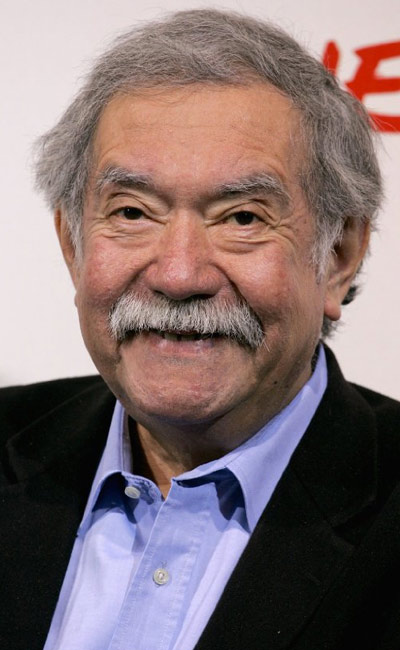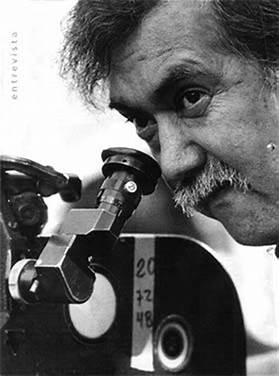 Filmmaker Raul Ruiz died at age 70 on August 19, 2011. The Chilean born Ruiz, who fled his native country in the wake of a 1973 coup d’etat to settle in France, turned out quite a few unforgettably bizarre films, including THE HYPOTHESIS OF THE STOLEN PAINTING, THREE CROWNS OF THE SAILOR, CITY OF PIRATES, THE GOLDEN BOAT and THE MYSTERIES OF LISBON. Ruiz was not a horrormeister by any stretch, yet he did at times dip his toe into the genre. A committed avant-gardist Ruiz undeniably was, but he occasionally tried to reach a broader audience, and those attempts were usually via horror movies.
Filmmaker Raul Ruiz died at age 70 on August 19, 2011. The Chilean born Ruiz, who fled his native country in the wake of a 1973 coup d’etat to settle in France, turned out quite a few unforgettably bizarre films, including THE HYPOTHESIS OF THE STOLEN PAINTING, THREE CROWNS OF THE SAILOR, CITY OF PIRATES, THE GOLDEN BOAT and THE MYSTERIES OF LISBON. Ruiz was not a horrormeister by any stretch, yet he did at times dip his toe into the genre. A committed avant-gardist Ruiz undeniably was, but he occasionally tried to reach a broader audience, and those attempts were usually via horror movies.
…he occasionally tried to reach a broader audience, and those attempts were usually via horror movies.
One such example is the 1981 no-budgeter THE TERRITORY, Ruiz’s premiere English language production. Based on an actual case of several French hikers who resorted to cannibalism in a vast wilderness, and partially financed by the inimitable Roger Corman, the film is known chiefly for the fact that Wim Wenders used THE TERRITORY’S entire cast and crew for his own no-budget wonder THE STATE OF THINGS. I feel, however, that THE TERRITORY deserves a cinematic footnote of its own, if only as a thoroughly ridiculous exercise in arty horror at its most pretentious. The great irony here is that Ruiz and Corman apparently envisioned a retro B-movie with all the trimmings, but that’s definitely not what resulted.
Mention of THE TERRITORY brings up a facet of Raul Ruiz’s 100 plus films that has been little mentioned in the Ruiz obituaries that have appeared thus far: the fact that quite a few of his films flat-out suck. This is of course inevitable considering Ruiz was a resolutely laid-back filmmaker who admittedly never got around to viewing the final cuts of many of his films; as one critic noted, Ruiz “doesn’t even seem to care whether what he’s doing is good or not.”
For an example of Ruiz at his finest, and a film that fits (at least partially) into the horror genre, check out DOG’S DIALOGUE (COLLOQUE DE CHIENS), a 21-minute short from 1977. It consists of verite footage of barking dogs and street life, interspaced with an outrageously convoluted story related entirely through still shots and narration (a la Chris Marker’s LA JETEE, an evident influence). Outrageously melodramatic, the narrative involves debauchery, gender confusion, adultery, murder and dismemberment, while the use of still pictures has the effect of offsetting the craziness, if not neutralizing it entirely. As for the baking dogs, I’m not entirely sure what they represent, but it does seem worth pondering.
The above is what Ruiz was capable of on a good day. For the opposite check out 1998’s ludicrous SHATTERED IMAGE. In another evident attempt at connecting with mainstream audiences, Ruiz shot this Vancouver-set film in English with two C-list stars-–LA FEMME NIKITA’S Anne Parillaud and William Baldwin-–and a storyline that has Parillaud leading parallel lives as a sultry assassin and naïve newlywed. I’ll grant that it sounds interesting, but it plays out in the most clichéd and obvious manner imaginable. Reviewers of course found the film “seductive” and “intriguing,” which attests to Ruiz’s status as a critics’ darling; I guarantee that if any other filmmaker perpetrated this mess the film would have assuredly gotten the type of reviews it deserved!
A more effective Ruiz exercise in surreal horror was 1992’s DARK AT NOON (L’OEIL QUI MENT), one of the maestro’s nuttiest (and most obscure) offerings. It’s about a dude who arrives in a town where people are buried alive and prosthetic limbs are an obsession. Among this town’s residents are the Virgin Mary, who floats in the air and sets fires, and a mysterious old man whose body is inhabited by the disembodied souls of his daughter and her husband. I find it difficult to believe, but this loony example of weirdness-for-weirdness’ sake was one of Ruiz’s biggest budgeted films, having been shot in 35mm with much of the dialogue in English, as well as John Hurt and David Warner in pivotal roles.
Less inspiring was 2008’s NUCINGEN HOUSE (LA MAISON NUCINGEN), a relentlessly labored digitally shot riff on any number of horror movie clichés. Unfortunately there’s very little else to the film, which is suffocatingly half-baked and self-conscious. It involves Lars von Trier regular Jean-Marc Barr, who visits the titular residence together with his sweetie, only to be assailed with all manner of freakiness on the part of mischievous ghosts.
Finally, to end this overview on a positive note, let’s take a look at 1987’s THE BLIND OWL (LA CHOUETTE AVEUGLE), a loose adaptation of Sadegh Hedayat’s classic novel. It features a projectionist at an Arabic movie theater becoming transfixed by a dancing woman on the screen. That’s just the start of an insanely wide-ranging narrative that sees Ruiz gleefully pile on all manner of complications until it’s impossible to discern what is supposed to be “real” and what isn’t. There are many impressively visualized moments, as well as some mildly gruesome ones (severed body parts are a constant), with a style that playfully emulates the overheated melodrama of traditional horror and mystery filmmaking. THE BLIND OWL’S relentlessly self-referential nature can be distracting, if not downright irritating, but for those willing to stick with it the film is an undeniably fascinating mind-twister.
novel. It features a projectionist at an Arabic movie theater becoming transfixed by a dancing woman on the screen. That’s just the start of an insanely wide-ranging narrative that sees Ruiz gleefully pile on all manner of complications until it’s impossible to discern what is supposed to be “real” and what isn’t. There are many impressively visualized moments, as well as some mildly gruesome ones (severed body parts are a constant), with a style that playfully emulates the overheated melodrama of traditional horror and mystery filmmaking. THE BLIND OWL’S relentlessly self-referential nature can be distracting, if not downright irritating, but for those willing to stick with it the film is an undeniably fascinating mind-twister.
So Raul Ruiz may not have been the most consistent of filmmakers. Yet his fearlessness, probing intelligence and willingness to push the boundaries of cinema are increasingly scarce commodities, and the mark of a talent whose likes we won’t be seeing again.
R.I.P. Raul Ruiz.
